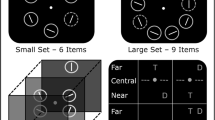Abstract
The aim of this study was to investigate the spatial orienting of visual attention in depth under purely stereoscopic viewing conditions. Random-dot stereograms were used to present disparity-defined target stimuli that were either validly or invalidly cued in depth. In separate tasks, participants responded either to the relative depth of the target (protruding vs. receding) or to its shape (square vs. diamond). Stimulus onset asynchronies (SOAs) between an uninformative exogenous cue and target were varied from 250 to 600 ms. For both tasks, mean response times (RTs) were shorter for validly than invalidly cued target depths and this RT advantage was essentially restricted to the shortest SOA of 250 ms. These results indicate that attention can be reflexively allocated to locations in stereo depth under conditions of low perceptual load, and independent of whether depth is relevant to the task or not.



Similar content being viewed by others
References
Andersen, G. J. (1990). Focused attention in three-dimensional space. Perception & Psychophysics, 47(2), 112–120.
Andersen, G. J., & Kramer, A. F. (1993). Limits of focused attention in three-dimensional space. Perception & Psychophysics, 53(6), 658–667.
Arnott, S. R., & Shedden, J. M. (2000). Attention switching in depth using random-dot autostereograms: Attention gradient asymmetries. Perception & Psychophysics, 62, 1459–1473.
Atchley, P., & Kramer, A. F. (2001). Object and space-based attentional selection in three-dimensional space. Visual Cognition, 8, 1–32.
Atchley, P., Kramer, A. F., Andersen, G. J., & Theeuwes, J. (1997). Spatial cueing in a stereoscopic display: Evidence for a “depth-aware” attentional focus. Psychonomic Bulletin & Review, 4, 524–529.
Downing, C., & Pinker, S. (1985). The spatial structure of visual attention. In M. I. Posner & O. S. M. Martin (Eds.), Attention and performance XI (pp. 171–187). Hillsdale: Erlbaum.
Gawryszewski, L. D. G., Riggio, L., Rizzolatti, G., & Umiltà, C. (1987). Movements of attention in the three spatial dimensions and the meaning of “neutral” cues. Neuropsychologia, 25, 19–29.
Ghiradelli, T. G., & Folk, C. L. (1996). Spatial cuing in a stereoscopic display: Evidence for a “depth-blind” attentional spotlight. Psychonomic Bulletin & Review, 3, 81–86.
Harris, J. M., McKee, S. P., & Watamaniuk, S. N. J. (1998). Visual search for motion-in-depth: Stereomotion does not ‘pop-out’ from disparity noise. Nature Neuroscience, 1, 165–168.
He, Z. J., & Nakayama, K. (1995). Visual attention to surfaces in three dimensional space. Proceedings of the National Academy of Sciences, 92, 11155–11159.
Howard, I. P., & Rogers, B. J. (2002). Seeing in Depth: Depth Perception (Vol. 2). Toronto, Canada: Porteous, I.
Iavecchia, H. P., & Folk, C. L. (1994). Shifting visual attention in stereographic displays: A time course analysis. Human Factors, 36, 606–618.
Julesz, B. (1971). Foundations of cyclopean perception. Chicago: University of Chicago Press.
Lavie, N. (1995). Perceptual load as a necessary condition for selective attention. Journal of Experimental Psychology: Human Perception and Performance, 21, 451–468.
Loftus, G. R., & Masson, M. E. J. (1994). Using confidence intervals in within-subjects designs. Psychonomic Bulletin & Review, 1, 476–490.
Marrara, M. T., & Moore, C. M. (2000). Role of perceptual organization while attending in depth. Perception & Psychophysics, 62, 786–799.
Masson, G. S., Busettini, C., & Miles, F. A. (1997). Vergence eye movements in response to binocular disparity without depth perception. Nature, 389, 283–286.
Posner, M. I. (1980). Orienting of attention. Quarterly Journal of Experimental Psychology, 32, 3–25.
Posner, M. I., & Cohen, Y. (1984). Components of visual orienting. In H. Bouma & D. Bouwhuis (Eds.), Attention & Performance X: Control of language processes (pp. 531–556). Hillsdale, NJ: Erlbaum.
Posner, M. I., Cohen, Y., & Rafal, R. D. (1982). Neural systems control of spatial orienting. Philosophical Transactions of the Royal Society of London, 298, 187–198.
Posner, M. I., & Petersen, S. E. (1990). The attention system of the human brain. Annual Review of Neuroscience, 13, 25–42.
Previc, F. H. (1998). The neuropsychology of 3-D space. Psychological Bulletin, 124, 123–164.
Prinzmetal, W., Zvinyatskovskiy, A., Gutierrez, P., & Dilem, L. (2009). Voluntary and involuntary attention have different consequences: The effect of perceptual difficulty. Quarterly Journal of Experimental Psychology, 62(2), 352–369.
Theeuwes, J., & Pratt, J. (2003). Inhibition of return spreads across 3-D space. Psychonomic Bulletin & Review, 10, 616–620.
Tyler, C. W. (1974). Depth perception in disparity gratings. Nature, 251, 140–142.
Wright, R. D., & Ward, L. M. (2008). Orienting of Attention. New York: Oxford University Press.
Acknowledgments
We would like thank Ursula Bauer for her valuable feedback as test observer, Stephanie Jainta for her advice, and two anonymous reviewers for constructive comments.
Author information
Authors and Affiliations
Corresponding author
Additional information
This article is dedicated to the memory of our colleague Walter H. Ehrenstein who sadly passed away in January 2009.
Rights and permissions
About this article
Cite this article
Bauer, D., Plinge, A., Ehrenstein, W.H. et al. Spatial orienting of attention in stereo depth. Psychological Research 76, 730–735 (2012). https://doi.org/10.1007/s00426-011-0396-6
Received:
Accepted:
Published:
Issue Date:
DOI: https://doi.org/10.1007/s00426-011-0396-6




